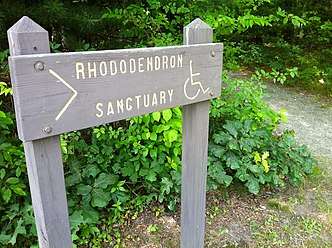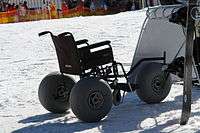Accessible tourism
Accessible tourism is the ongoing endeavour to ensure tourist destinations, products and services are accessible to all people, regardless of their physical limitations, disabilities or age. It encompasses publicly and privately owned tourist locations. The term has been defined by Darcy and Dickson (2009, p34) as:
Accessible tourism enables people with access requirements, including mobility, vision, hearing and cognitive dimensions of access, to function independently and with equity and dignity through the delivery of universally designed tourism products, services and environments. This definition is inclusive of all people including those travelling with children in prams, people with disabilities and seniors.[1]
_1981%2C_MiNr_2622.jpg)

Overview
Modern society is increasingly aware of the concept of integration of people with disabilities. Issues such as accessibility, design for all and universal design[2] are featured in the international symposia of bodies such as the European Commission.[3] Steps have been taken to promote guidelines and best practices, and major resources are now dedicated to this field.
A greater understanding of the accessible tourism market has been promoted through research commissioned by the European Commission where a stakeholder analysis has provided an insight into the complexities of accessible tourism.[4] Similarly, the Australian Sustainable Tourism Cooperative Research Centre funded an Accessible Tourism Research Agenda[5] that sought to outline a research base on which to develop the supply, demand and coordination/regulation information required to develop the market segment. The research agenda has now seen three other funded projects contribute towards a research base on which the tourism industry and government marketing authorities can make more informed decisions.[6][7][8]
As of 2008, there were more than 50 million persons with disabilities in Europe, and more than 600 million around the world. When expanded to include all beneficiaries of accessible tourism, as defined above, the number grows to some 130 million people affected in Europe alone.[9] According to the World Report on Disability by World Health Organization and the World Bank in 2011, over 1 billion of people in the world had some disability, of whom nearly 200 million experienced severe difficulty in functioning.[10]
In addition to the social and health benefits[11], the market represents an opportunity for new investment and new service requirements, rarely provided by key players in the tourism sector.
According to ENAT, the European Network for Accessible Tourism, accessible tourism includes:[9]
- Barrier-free destinations: infrastructure and facilities
- Transport: by air, land and sea, suitable for all users
- High quality services: delivered by trained staff
- Activities, exhibits, attractions: allowing participation in tourism by everyone
- Marketing, booking systems, web sites & services: information accessible to all
Specific needs and requirements
Specific problems found by travellers or tourists with disabilities include:
- Inaccessible, or only partly accessible, web sites
- Lack of accessible airport transfer
- Lack of wheelchair accessible vehicles
- Lack of well-adapted hotel rooms
- Lack of professional staff capable of dealing with accessibility issues
- Lack of reliable information about a specific attraction's level of accessibility
- Lack of accessible restaurants, bars, and other facilities
- Lack of adapted toilets in restaurants and public places
- Inaccessible streets and sidewalks
- Lack of technical aids and disability equipment such as wheelchairs, bath chairs and toilet raisers
 A campground picnic table made accessible to wheelchairs and walkers with its extended top.
A campground picnic table made accessible to wheelchairs and walkers with its extended top. An accessible "boardwalk" ramp with landings for stopping to enjoy a panorama view. Harris Beach State Park, Brookings, Oregon.
An accessible "boardwalk" ramp with landings for stopping to enjoy a panorama view. Harris Beach State Park, Brookings, Oregon. Kapiti Island coast accessible beach, wheelchair ramp, Paekakariki, Wellington, New Zealand.
Kapiti Island coast accessible beach, wheelchair ramp, Paekakariki, Wellington, New Zealand. An accessible yurt shelter in Pinery Provincial Park, Ontario, Canada.
An accessible yurt shelter in Pinery Provincial Park, Ontario, Canada. An accessible shower stall at a State park in Virginia.
An accessible shower stall at a State park in Virginia. Morgan's Wonderland is an accessible family amusement park in San Antonio, Texas, designed similar to a sensory garden with interactive games.
Morgan's Wonderland is an accessible family amusement park in San Antonio, Texas, designed similar to a sensory garden with interactive games. A wheelchair with adaptive tires for travelling across snow at a ski hill. Such chairs can be loaned or rented to users.
A wheelchair with adaptive tires for travelling across snow at a ski hill. Such chairs can be loaned or rented to users.
Brief history
Europe and the United States of America are home to the majority of the existing companies in this niche. However, companies worldwide are starting to appear as the result of a growing need, largely driven by senior tourism, due to increasing life expectancy in developed countries. The United States requires ADA compliant ramp access to virtually all businesses and public places.[12]
Portugal, Spain, the United Kingdom, Germany, France and other northern European countries are increasingly prepared to receive tourists in wheelchairs, and to provide disability equipment and wheelchair accessible transport.
With the growth of the internet, online travel planning is also becoming more common, leading to the rise of online accessibility maps. Starting in 2016, Lonely Planet started offering online resources by country.
References
- , Darcy, S., & Dickson, T. (2009). A Whole-of-Life Approach to Tourism: The Case for Accessible Tourism Experiences. Journal of Hospitality and Tourism Management, 16(1), 32-44.
- Preiser, W. F. E., & Ostroff, E. (2001). Universal Design Handbook. New York: McGraw-Hill.
- European and International Associations at the European Commission's Enterprise and Industry Tourism web page Archived January 30, 2009, at the Wayback Machine.
- Buhalis, D., Michopoulou, E., Eichhorn, V., & Miller, G. (2005). Accessibility market and stakeholder analysis - One-Stop-Shop for Accessible Tourism in Europe (OSSATE). Surrey, United Kingdom: University of Surrey. http://www.ossate.org/doc_resources/OSSATE_Market&Stakeholder%20Analysis_Public_Version_Fina..pdf Archived 2013-07-29 at the Wayback Machine Retrieved 2012.08.26
- Darcy, S. (2006). Setting a Research Agenda for Accessible Tourism. STCRC Technical Report Series, Gold Coast - Australia. Available from http://www.crctourism.com.au/BookShop/BookDetail.aspx?d=473
- Darcy, S., Cameron, B., Pegg, S., & Packer, T. (2008). Technical Report 90042: Developing Business Cases for Accessible Tourism, STCRC technical report Available from http://www.crctourism.com.au/BookShop/BookDetail.aspx?d=582 Archived 2010-03-23 at the Wayback Machine
- Darcy, S., Cameron, B., Dwyer, L., Taylor, T., Wong, E., & Thomson, A. (2008). Technical Report 90064: Visitor accessibility in urban centrespp. 75). Available from http://www.crctourism.com.au/BookShop/BookDetail.aspx?d=626 Archived 2010-03-23 at the Wayback Machine at
- Packer, T., Small, J., & Darcy, S. (2008). Technical Report 90044: Tourist Experiences of Individuals with Vision Impairment STCRC Technical Report Available from http://www.crctourism.com.au/BookShop/BookDetail.aspx?d=602 Archived 2010-03-23 at the Wayback Machine
- "ENAT - European Network for Accessible Tourism". Archived from the original on 20 December 2008. Retrieved 2008-12-04.
- "World Report On Disability 2011" (PDF).
- Southall, Jo (2016-05-31). "Benefits of Leisure for Disabled and Elderly". Limitless Travel. Archived from the original on 2019-09-19. Retrieved 2019-09-19.
- "ADA Specifications for Wheelchair use". Retrieved 10 October 2016.
External links
| Wikimedia Commons has media related to Accessible tourism. |
| Wikivoyage has a travel guide for Accessible tourism. |
- Accessible tourism at the Open Directory Project